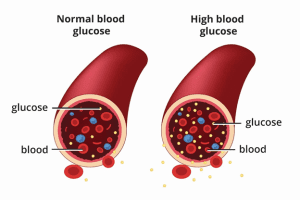TAG: GS 3: SCIENCE AND TECHNOLOGY
THE CONTEXT: Recent research published in The Lancet Diabetes and Endocrinology has provided compelling evidence linking high glycemic index (GI) diets with an increased risk of type 2 diabetes.
EXPLANATION:
- This comprehensive study, conducted across multiple continents, sheds light on the intricate relationship between dietary choices, GI, and diabetes risk.
Understanding Glycemic Index and Load:
- Glycemic index (GI) is a measure that ranks carbohydrate-containing foods based on their postprandial blood glucose response.
- Foods with a higher GI led to a more significant increase in blood sugar levels. Glycemic load (GL), on the other hand, considers both the quality and quantity of carbohydrates in a specific food item.
- It is calculated by multiplying the GI by the amount of carbohydrate in a serving.
Controversies Surrounding GI and Diabetes:
- Despite the intuitive connection between high GI diets and blood sugar levels, the association with diabetes has been a subject of debate.
- Previous evidence has been limited, and the applicability to larger populations has been questioned.
- The Lancet study seeks to address these controversies by providing robust evidence from a diverse cohort.
Study Design and Participants:
- The study, part of the Prospective Urban and Rural Epidemiology (PURE) project, involved 127,594 adults aged 35–70 years from 20 countries across different income levels.
- Participants were free from known diabetes at baseline and were followed up for nearly 12 years.
- Their dietary intake was assessed using country-specific food frequency questionnaires, and GI and GL were estimated based on carbohydrate intake from seven food categories.
Key Findings:
- After the follow-up period, 7,326 cases of type 2 diabetes were identified.
- The analysis revealed a significant association between dietary GI and the risk of developing type 2 diabetes.
- Individuals with diets higher in GI were found to have a heightened risk of diabetes.
- Moreover, participants with higher GL were also at increased risk compared to those with lower GL.
- Interestingly, the study observed that the association between GI and diabetes risk was particularly pronounced among individuals with a higher Body Mass Index (BMI).
- This highlights the interplay between dietary factors and metabolic health, emphasizing the importance of personalized dietary recommendations tailored to individual characteristics.
Implications for Diabetes Prevention:
- The study’s findings suggest that adopting low GI and low GL diets may serve as a preventive measure against the development of type 2 diabetes.
- By choosing foods that result in lower postprandial blood glucose levels, individuals can potentially mitigate their diabetes risk, especially those with higher BMIs or family histories of the condition.
Diabetes:
- Diabetes is a disease that occurs when your blood glucose, also called blood sugar, is too high.
- Glucose is your body’s main source of energy. Your body can make glucose, but glucose also comes from the food you eat.
- Insulin is a hormone made by the pancreas that helps glucose get into your cells to be used for energy.
- If you have diabetes, your body doesn’t make enough—or any—insulin, or doesn’t use insulin properly. Glucose then stays in your blood and doesn’t reach your cells.
- Diabetes raises the risk for damage to the eyes, kidneys, nerves, and heart. Diabetes is also linked to some types of cancer.
- Taking steps to prevent or manage diabetes may lower your risk of developing diabetes health problems.

Type 2 diabetes
- If one has type 2 diabetes, the cells in the body don’t use insulin properly.
- The pancreas may be making insulin but is not making enough insulin to keep your blood glucose level in the normal range.
- Type 2 diabetes is the most common type of diabetes. One is more likely to develop type 2 diabetes if you have risk factors, such as overweight or obesity, and a family history of the disease. One can develop type 2 diabetes at any age, even during childhood.
- Type 2 diabetes can be delayed or prevented by knowing the risk factors and taking steps toward a healthier lifestyle, such as losing weight or preventing weight gain.


